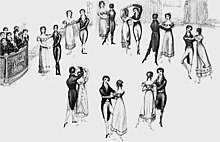<<GotoNote

The waltz (from German Walzer [ˈvalt͡sɐ̯]) is a ballroom and folk dance, normally in triple (help·info) time, performed primarily in closed position.
There are many references to a sliding or gliding dance that would evolve into the waltz that date from 16th century Europe, including the representations of the printmaker Hans Sebald Beham. The French philosopher Michel de Montaigne wrote of a dance he saw in 1580 in Augsburg, where the dancers held each other so closely that their faces touched. Kunz Haas (of approximately the same period) wrote, "Now they are dancing the godless Weller or Spinner."[1] "The vigorous peasant dancer, following an instinctive knowledge of the weight of fall, uses his surplus energy to press all his strength into the proper beat of the bar, thus intensifying his personal enjoyment in dancing."[1]
The peasants of Bavaria, Tyrol, and Styria began dancing a dance called Walzer, a dance for couples, around 1750. The Ländler, also known as the Schleifer, a country dance in 34 time, was popular in Bohemia, Austria, and Bavaria, and spread from the countryside to the suburbs of the city. While the eighteenth century upper classes continued to dance the minuets (such as those by Mozart, Haydn and Handel), bored noblemen slipped away to the balls of their servants.[2]
In the 1771 German novel Geschichte des Fräuleins von Sternheim by Sophie von La Roche, a high-minded character complains about the newly introduced waltz among aristocrats thus: "But when he put his arm around her, pressed her to his breast, cavorted with her in the shameless, indecent whirling-dance of the Germans and engaged in a familiarity that broke all the bounds of good breeding—then my silent misery turned into burning rage."[3]
Describing life in Vienna (dated at either 1776 or 1786[4]), Don Curzio wrote, "The people were dancing mad ... The ladies of Vienna are particularly celebrated for their grace and movements of waltzing of which they never tire." There is a waltz in the second act finale of the 1786 opera Una Cosa Rara by Martin y Soler. Soler's waltz was marked andante con moto, or "at a walking pace with motion", but the flow of the dance was sped-up in Vienna leading to the Geschwindwalzer, and the Galloppwalzer.[5][6]
In the transition from country to town, the hopping of the Ländler, a dance known as Langaus, became a sliding step, and gliding rotation replaced stamping rotation.[4]
...https://en.wikipedia.org/wiki/Waltz